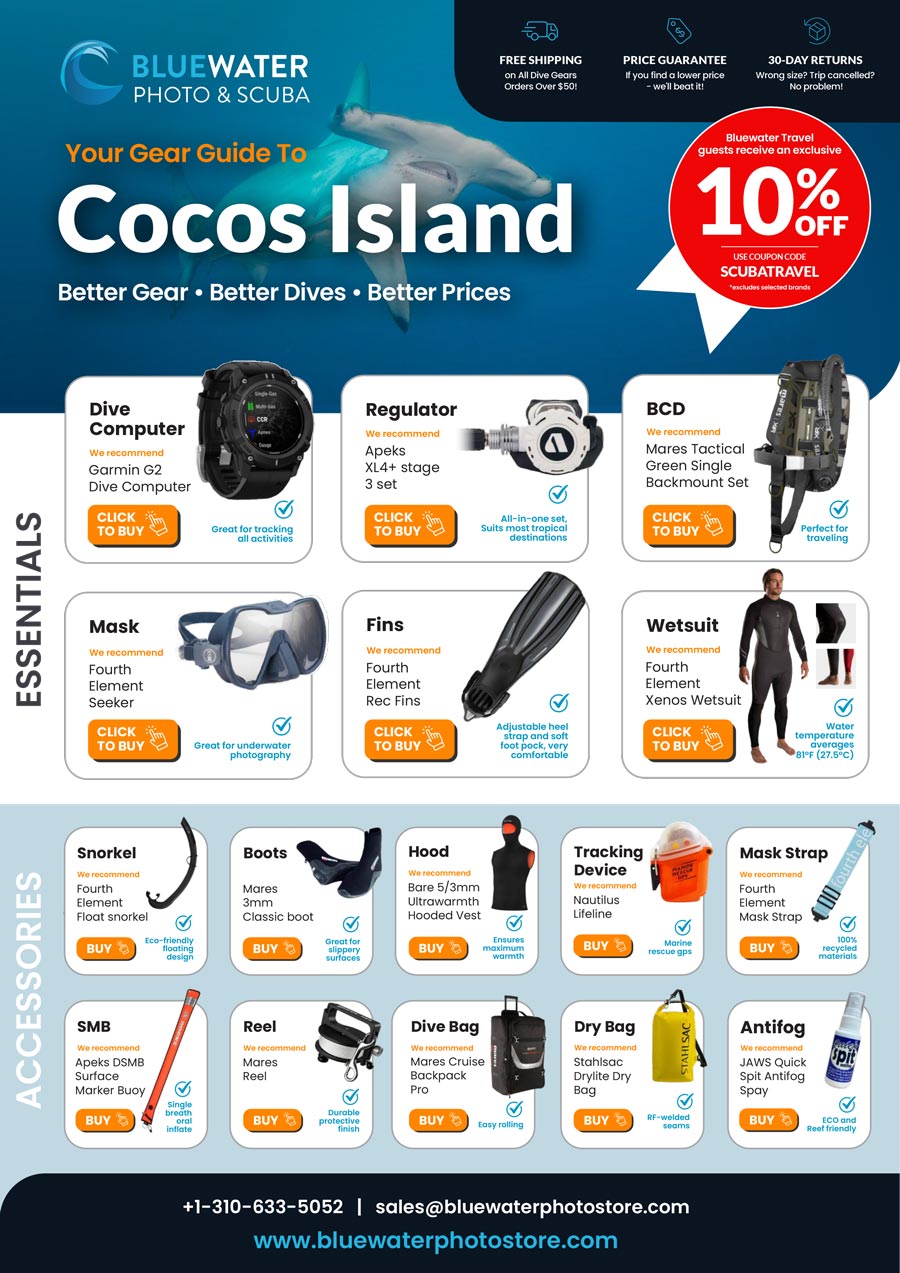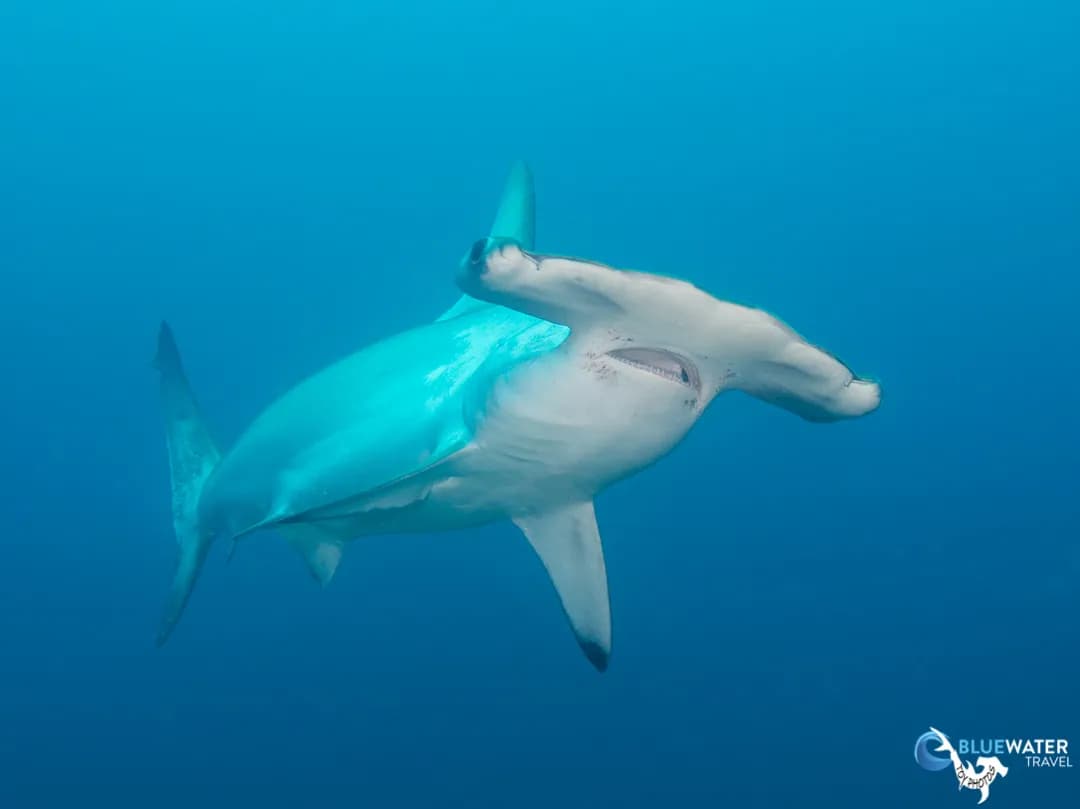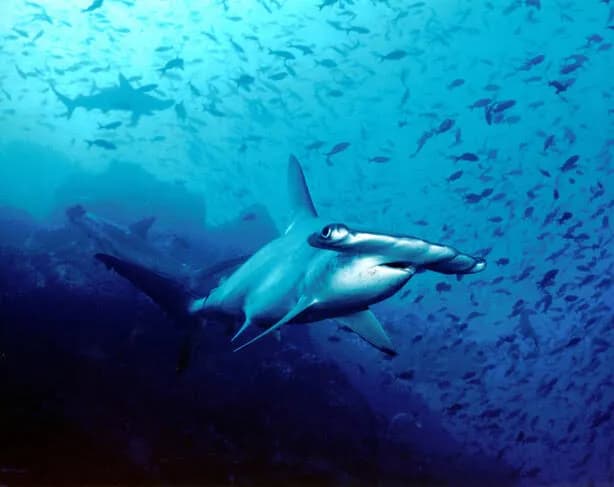Best Scuba Diving in Cocos Island
Cocos Island is one of the world's best scuba diving destinations for diving with big animals. Schooling hammerhead sharks is what the Cocos Island diving scene is most famous for, but you can find many other shark and ray species, including white tip reef sharks, silky sharks, the occasional whale sharks, manta rays and marble rays.
Destination Highlights
Scuba Dive Level
Advanced Diver
Visibility
50 to 100 feet (15 to 30 meters)
Average Water Temperature
80
Pelagic Encounters
Shark Encounters
Scuba Diving in Cocos Island, Costa Rica
Cocos Island Diving Highlights
Cocos Island is one of the world's best scuba diving destinations for diving with big animals. Schooling hammerhead sharks is what the Cocos Island diving scene is most famous for, but you can find many other shark and ray species, including white tip reef sharks, silky sharks, the occasional whale sharks, manta rays and marble rays.
Cocos is also home to 27 endemic fish species including the red-lipped batfish, that are also commonly found in the Galapagos. Divers can also see large schools of jacks and tuna, Creole fish, green turtles, and octopus, and the list goes on...
Intro To Cocos Island
Belongong to Costa Rica, Cocos Island is the mecca for divers looking for big animals, open ocean, and advanced diving. Howard Hall's film "Island of the Sharks" was filmed here, and sharks are the main attraction. Cocos Island is not a place with pretty corals or reefs. It is a gorgeous, uninhabited island, approximately 5 x 2 miles (8 x 3 km) in size. The bottom is a sloping rocky substrate without a lot of colors.
Find out about other places to scuba dive in Costa Rica.
What you do get with Cocos Island diving is amazing marine life - prolific shark populations including reef whitetip and scalloped hammerheads, plus a chance of many other species. There is also great schooling fish action, and a good chance of seeing true pelagics like wahoo, tuna, and even billfish. If you are comfortable with deep (100ft) nitrox diving in open oceans, and the possibility of swell, strong currents and low vis, Cocos Island can be the apex dive trip of your dive career. It is not a place for non-divers.
Interested in pretty coral reefs?Scuba diving in the Philippinesis a great option.
Cocos Island is quite a beautiful island to look at topside, and short excursions to the island are possible, but you are on the boat almost all of the time. The island is lush and green with rainforest and waterfalls. Malpelo Island is another destination that Cocos liveaboards sometimes visit during the same trip. It is not that attractive and you can not go ashore.
Diving Information
Cocos Island Diving With Hammerhead Sharks
Hammerhead sharks are drawn to Cocos Island to be cleaned by King angelfish, butterflyfish and other small fish. These islands are basically giant cleaning stations.
Other Marine Life In Cocos Island
Scuba diving in Cocos Island is always exciting, with dozens of white-tip sharksusually seen on every dive, at any depth, cruising around the rocks. Enormous schools of big-eyed jacks, barracuda, snappers and grunts are seen on many dives, and the size of these schools must be seen in person to appreciate.
Marble rays are very frequently seen in groups of 5-20, feeding on the bottom at 100ft. Marble rays are easy to approach and are always cruising around like they are on parade.
Whale sharks occasionally pass through, and there are often a couple of sightings on a trip. Large tuna, mantas, silky and silvertip sharks are often seen as are eagle rays. Orcas, tiger sharks, dolphins, wahoo, and sailfish are also seen but not on every trip.
Dolphins and tiger sharks are quite frequently seen, up close. Divers have seen dolphins hunting jacks. Galapagos sharks, which can be aggressive, are not as common but do sometimes appear.
Cocos Island Diving Conditions
- Water Temperatures: In June/July, the water is sometimes 81 degrees at all depths. It stays from 80-82 during the summer. The water can get much colder, down in the lower 70s in the winter. Thermoclines are common, and deep down can get into the 60s.
- Visibility: In June, July the visibility was 50-70ft. Visibility can be variable but 30-50ft is the norm, with even better visibility from Jan - May.
- Depth Range: 30 131 feet (10 40m)
Typical Cocos Island Scuba Dive
On a typical scuba dive at Cocos Island, you drop down as a group to a depth of 100ft, spread out and find a rock to hide behind. You then look for a cleaning station for hammerhead sharks, which is often a larger rock with many angelfish and butterflyfish around it. Hammerhead sharks are easily spooked by erratic divers' flailing limbs and exhaust bubbles. Attempting to approach these sharks usually only leads to their quick retreat. In order to get a chance at a close approach, enabling opportunities for good photographs, quickly and carefully locating a suitable rock to hide behind and controlling your buoyancy and breathing is essential.
Divers are advised to become "blue" divers; (holding your breath when the sharks approach). By following the divemaster's directions, calming down, being patient you will greatly improve your chances of close passes and prolonged encounters.
3 dives a day are the norm at Cocos Island, with occasional night dives. On several days a night dive will be offered with white-tipped reef sharks. Divers' lights illuminating the fish causes a feeding frenzy with the sharks. Any fish or turtle illuminated by a dive light will be quickly assassinated by several sharks, and because of this, some divers may not enjoy this dive or choose not to do it. On a remote trip like this, you need to pay attention to your depth & time, and follow the divemaster's instructions carefully, and double check your surface marker buoy at the beginning of each dive.
How To Get To Cocos Island
Liveaboards depart from Puntarenas, Costa Rica, a two-hour bus transfer from San José’s Juan Santamaría International Airport (SJO). Travel time is approximately 40 hours to Cocos Island, 43 hours to Malpelo, and 40 hours from Cocos to Malpelo. At certain times of the year, the crossing can be very rough with big swells and seasick passengers.
How To Scuba Dive Cocos Island
The only way to get to the island is via liveaboard dive boats. Most liveaboards offer 10-day trips, with 7 days of diving and 3 dives a day.
Best Time To Scuba Dive Cocos Island
Scuba diving Cocos Island can be done in both rainy season and dry season. If you visit the islands in June/July, you may have a chance of having both big animal encounters and calm seas. The dry season is Dec - May, which can bring silky sharks, dolphins and mobulas, calmer waters and smoother crossings. The rainy season is June - Nov; and crossings can be a little rough, there's a lot of rain, but Hammerhead sharks are in larger numbers. That said, you will usually see good numbers of hammerheads throughout the year. May - Aug are probably the best months to go, but sightings/conditions can be highly variable. Note that hammerhead sharks sometimes go deep during an "El Nino" year.
Topside & Non-Diving Activities
Costa Rica is one of the top nature destinations in the world. There are excellent opportunities to see monkeys, toucans, brilliantly colored tree frogs, parrots, sloths, and many more birds and animals. The country is small, easy to travel around, and relatively safe. Make sure you know what to pack for Costa Rica so you've got everything you need to enjoy every minute of your trip without having to worry where to find it when you're there! We highly recommend some time exploring the county either before or after your Cocos trip. There are not many non-diving activities at Cocos Island itself.
Practical Information
- Currency: Costa Rican Coln (CRC)
- Language: The official language is Spanish, but English is widely spoken within tourism-related areas
- Main Airport Code: SJO
- Time Zone: UTC-6
- Electricity: 120V / 60Hertz
Recommended Scuba Gear
Download our full scuba gear guide to Cocos, Bluewater Travel guests receive 10% OFF!



